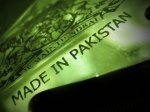Compiled by: Mirza Rohail B
The manufacturing sector grew at an average rate of 8 percent from the sixties to the eighties, but fell to 3.9 percent  during the nineties. This was mainly caused by reduction in investment levels due to lack of continuity and consistency in policies. Political instability law and order position in the major industrial centers, transport bottlenecks, as well as unreliability and inadequate availability of power supply at affordable rates were additional factors pulling down the sector.
during the nineties. This was mainly caused by reduction in investment levels due to lack of continuity and consistency in policies. Political instability law and order position in the major industrial centers, transport bottlenecks, as well as unreliability and inadequate availability of power supply at affordable rates were additional factors pulling down the sector.
The sector has shown impressive recovery recently and has grown at a compound rate of 10.9 percent per annum during 2001 – 05, with Large Scale Manufacturing (LSM) growing even faster, becoming 19.9% in 2005.
The contribution of Large-Scale Manufacturing at basic prices stand at Rs 844 billion as compared with Rs 264 billion in 2000-01, figures from the Census of Large-Scale Manufacturing Industries (CMI) 2005-06 show.
LSM contribution to GDP also called as Gross Value Added (GVA) at producers’ prices has been estimated at Rs 912 billion as compared with the previous Census 2000-01 amount of Rs 280 billion.Political and macroeconomic stability, rationalization of tariffs, increase in investments, improved utilization of productive capacity, and growth in demand for manufactured products, resulting from higher exports and consumer financing have been the major factors leading to this growth.
Large Scale Manufacturing
1999 and 2000 – 1.5%
2000 and 2001 – 11%
2001 and 2002 – 3.5%
2002 and 2003 – 7.2%
2003 and 2004 – 18.1%
2004 and 2005 – 19.9%
2005 and 2006 – 8.7%
2006 and 2007 – 8.6%
2007 and 2008 – 5%
Census of Large-Scale Manufacturing Industries
The contribution of Large-Scale Manufacturing at basic prices stand at Rs 844 billion as compared with Rs 264 billion in 2000-01, figures from the Census of Large-Scale Manufacturing Industries (CMI) 2005-06 show.
The CMI is conducted after every five years using the frame of Provincial Labour Departments .It is conducted by Federal Bureau of Statistics (FBS) in collaboration with Provincial Directorates of Industries and Bureaus of Statistics (BoS) under the Industrial Statistics Act 1942. The basic price is the amount receivable by the producer from the purchaser for a unit of a good or service produced as output minus any tax payable, and plus any subsidy receivable.
Census of manufacturing industries 2005-06 shows value of production at Rs 2929 billion depicting an increase of 165 percent over Rs 1104 billion in CMI 2000-01. LSM contribution to GDP also called as Gross Value Added (GVA) at producers’ prices has been estimated at Rs 912 billion as compared with the previous Census 2000-01 amount of Rs 280 billion. Capital stock or value of fixed assets amounted to Rs 1147 billion at the end of fiscal year 2005-06 as compared with Rs 428 billion at the end of fiscal year 2000-01.
CMI 2005-06 frame was enhanced using industrial directories provided by provincial directorates of industries as well as results of Economic Census 2001 conducted by FBS. The total number of industries surveyed in CMI 2005-06 was 13,146 establishments. Out of these 6417 establishments supplied requisite data (compared to 4528 units in CMI 2000-01). 2364 establishments were found closed and 3213 establishments gave no response. The results of CMI would be cornerstone for the forthcoming revision of Pakistan’s National Accounts.
Pakistan Manufacturing Industry
Pakistan’s manufacturing industry is heavily dominated by food, textiles and apparel, and leather industries to the

JF-17 Thunder
extent of over 50 percent. The share of textiles and its derivatives in exports was as large as 67 percent in 2003-04. Other major segments in manufacturing include chemicals and pharmaceuticals (15.2 percent), basic metal industry (7.7 percent), nonmetallic mineral products (5.1 percent), machinery (4.6 percent), cement (4.4 percent), automobiles (4.4 percent). Automobiles, electronics, cement, fertilizers and textiles have all showed cumulative double digit growth during the last three years. An important feature of the engineering sector is the level of competence reflected in local design and local content, (with deletion levels of 80 – 100 percent in electrical goods, 56-89 percent in automobiles and motor cycles, and 75-100 percent in domestic appliances).
Manufacturing Statistics Progressive Year
Initial data for Jul-Sep FY08 suggested a deceleration in the growth of LSM production to only 6.9 percent.
Further, Large Scale Manufacturing (LSM) growth has declined to 5.57 per cent during the first five months (July-November) of the current financial year due to economic slow-down and high interest rates and poor law and order situation.
Similarly, improved prospects in transportation & storage sub-sectors on the back of relatively better production in major crops, strong contribution by finance and insurance sector and augmented administrative and defence related spending will provide support to adequate level of growth in the services sector. These prospects of the services sector would be neutralized to some extent by negative growth in the LSM, imports contraction, shrinking profits in the telecommunication sector. Leading indicators pertaining to the major sector wholesale and retail trade points towards a reasonable growth in this sub-sector. The targeted growth of 4.1 percent is already almost half of last year’s actual 8.2 percent.
Related Links:
Planning & Development Industry
Census Of Manufacturing Industries 2005-06 (Daily Times News)

Thanks much for article. It is very good stuff.
I enjoy to browse economicpakistan.wordpress.com!
hmmmmmmmm this is very informative material regarding LSM in Pakistan..
Pingback: Overall Vision of Our leader – Musharraf | Our leader - Musharraf
Pingback: President Musharraf’s Vision and Achievements of his tenure | Our leader - Musharraf